 |
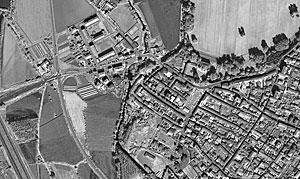 Since its release a year ago, ArcGIS Image Server has made a dramatic impact on the way GIS users are managing, processing, and serving imagery to their users. A complete enterprise solution, ArcGIS Image Server is fundamentally redefining how imagery is processed and distributed to end users. ArcGIS Image Server is unique in its ability to combine both on-the-fly server-based image processing with distribution to any client. It provides enterprise-wide access to very large image datasets within GIS, CAD, imaging, and Web applications, allowing users to manage, process, and quickly serve large quantities of raster data for visualization and analysis to a variety of clients. Since its release a year ago, ArcGIS Image Server has made a dramatic impact on the way GIS users are managing, processing, and serving imagery to their users. A complete enterprise solution, ArcGIS Image Server is fundamentally redefining how imagery is processed and distributed to end users. ArcGIS Image Server is unique in its ability to combine both on-the-fly server-based image processing with distribution to any client. It provides enterprise-wide access to very large image datasets within GIS, CAD, imaging, and Web applications, allowing users to manage, process, and quickly serve large quantities of raster data for visualization and analysis to a variety of clients.
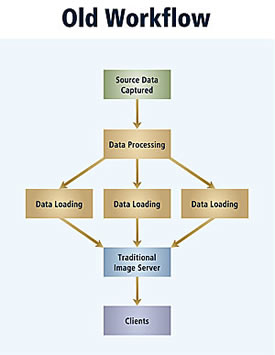 |
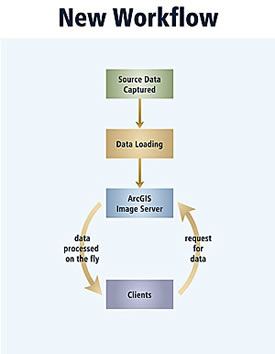 |
| ArcGIS Image Server improves workflows by eliminating the need to process source data and load multiple processed datasets onto a server. |
Traditionally, image processing and distribution have been considered two separate stages in image exploitation. This separation radically slows down processing, causes data redundancy, increases the amount of data that must be stored, and hinders efficient data management. Using ArcGIS Image Server, bottlenecks in conventional image-processing workflows can be resolved because raster datasets can be stored directly as files on servers, then processed and distributed at once without extensive preprocessing, conversion, or loading of the data into a database.
On-the-fly processing enables high-resolution georeferenced imagery to be distributed and made available to end users in a timely manner upon acquisition. This fast access to imagery reduces the latency between image capture and usage, thereby maximizing the value of imagery.
Users can tap into the server's processing power to generate multiple image products from a single data source, each with different radiometric processing, geometric processing, and compression options. These processes maximize the depth of the imagery and eliminate data management problems associated with multiple preprocessed datasets. This can substantially reduce data storage requirements. Server-side processing also enables access to raster data from thin client applications, thereby trimming down requirements for workstations that access and process the data.
Also for Preprocessed Image Products
ArcGIS Image Server is also being used by organizations that have large volumes of preprocessed or tiled imagery. Traditionally loading and maintaining such datasets have been difficult as the data often resides with multiple formats, projections, dates, and locations. This has required huge effort and time in processing and mosaicking the products into single seamless datasets. With ArcGIS Image Server, these datasets can be easily combined into image services with all conversion, reprojection, and mosaicking being performed on the fly.
Instant Return on Investment
ArcGIS Image Server provides value to any organization involved in image processing and/or distribution. By reducing data storage costs and reducing manpower required for data processing and maintenance, ArcGIS Image Server gives users an instant return on investment.
The immediate value of ArcGIS Image Server is derived from
- Fast access to geospatial imagery—ArcGIS Image Server provides access to source data without requiring any preprocessing, eliminating data redundancy and making imagery available to clients quickly. Plus, clients can access the data they need almost instantaneously, without lengthy load times.
- On-the-fly image processing—ArcGIS Image Server processes source data on the fly, minimizing storage requirements and reducing the latency between data capture and use by staff.
- Data and client interoperability—ArcGIS Image Server provides access to multiple image file formats from multiple clients, eliminating the need to convert source data into proprietary formats.
Full Scalability
| |
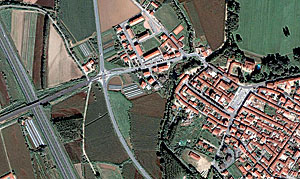
ArcGIS Image Server performs pan-sharpening on the fly, reducing disk storage requirements while ensuring that the nonpan-sharpened imagery is also available for spectral analysis. (QuickBird imagery courtesy of Digital Globe.) |
| |
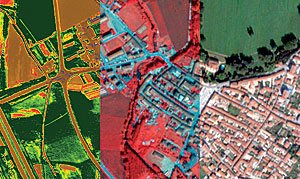 |
ArcGIS Image Server can scale to manage increasing demand and provide new functionality as imagery needs evolve. Image requests are passed to multiple service providers to support effective load balancing. Because additional service providers can be added as requirements increase, ArcGIS Image Server can scale to support very large processing demands. Additionally, optimized indexing enables ArcGIS Image Server to simultaneously serve many concurrent image requests by processing only the pixels required for a client's display. This reduces transmission data and frees ArcGIS Image Server for additional requests.
By supporting a scaling architecture, as well as additional program functionality through extensions and an included software developer kit (SDK), ArcGIS Image Server can meet the needs of both small organizations and large enterprises.
Operating System and Imagery Integration
ArcGIS Imager Server operates on low-cost Windows hardware and requires no special technology. ArcGIS Image Server is part of a complete integration of imagery into the core of the ArcGIS platform. At ArcGIS 9.3, Image Server is being fully integrated with ArcGIS Server and will be sold as an optional extension. This integration supports more seamless integration of imagery in ArcGIS and a broader set of standards for access.
More Information
Learn more about ArcGIS Image Server at www.esri.com/imageserver.
Sanborn
Sanborn, Colorado Springs, Colorado—a GIS, photogrammetric, and remote-sensing services provider—uses ArcGIS Image Server to serve large imagery datasets to its numerous clients. As a company that processes hundreds of terabytes of imagery per month, Sanborn immediately saw the advantages of ArcGIS Image Server and became an Esri implementation partner. The ability of ArcGIS Image Server to process data on the fly instead of preprocess or alter the source data intrigued Sanborn because part of the company's delivery process is facilitating a client QA review. ArcGIS Image Server, combined with ArcGIS Server, makes it possible for clients to perform QA reviews online rather than wait for datasets to be processed and delivered on CD. The online QA tool also reduces quality check error rates while ensuring customer requirements are met. "By offering immediacy and consistency, ArcGIS Image Server helps provide a turnkey solution in which Sanborn can offer clients the ability to easily manage large datasets through a time-saving quality assurance process," says John Copple, chief executive officer of Sanborn.
United States Department of Agriculture Forest Service
The United States Department of Agriculture (USDA) Forest Service Remote Sensing Applications Center (RSAC) in Salt Lake City, Utah, is using ArcGIS Image Server to quickly deliver vast amounts of imagery throughout its organization via an intranet. Prior to this implementation, the USDA Forest Service struggled to make large volumes of imagery available to staff in its nine regions across the 50 states. Users often had difficulty loading the imagery due to limited storage capacity. "We were looking for something that would move us up to an enterprise-level imagery management system," says Mike Morrison, training and technology awareness program leader for RSAC and manager of image software program deployment for the Forest Service. "We wanted to resolve storage management problems and be able to very quickly stream imagery to field offices. That's when we started looking at ArcGIS Image Server."
CenterPoint Energy
CenterPoint Energy, a large power company based in Houston, Texas, began using ArcGIS Image Server in the fourth quarter of 2006, adding its capability to the company's enterprise-wide ArcGIS system. Its ArcGIS Image Server application was initially configured to support mission-critical needs in the event of a large-scale natural disaster, such as a hurricane, that disrupts service to CenterPoint customers. "We set ambitious goals for using our imagery data, and we needed fast processing times to meet these demands," says Cynthia Salas, the company's GIS manager. "When we tested ArcGIS Image Server, we found designers, technicians, and digitizers were all very pleased with the processing time. It was twice as fast, in some cases even faster, than previous systems. And they were impressed with the resolution. This is the first time, since I've been here, [that] we have tested new technology and staff immediately came to us requesting that technology go into full production."
|
|